
THE KLON CENTAUR GUIDE
I often get inquiries from people about the authenticity of Klon Centaur units they either have or are thinking of buying. With prices on the rise in the used market and the growing number of counterfeits, it’s becoming more and more essential to be certain you’re getting the real deal. To help people confidently acquire an authentic Klon Centaur, or for those who just want to learn more about this legendary pedal, I’ve put together this guide.
Keep in mind that this guide isn’t meant to be the ultimate authority on the subject. Rather, it’s based on my personal experiences with my own Centaurs, those belonging to clients and friends, and a detailed examination of a vast collection of Klon Centaur photos I’ve collected online over the years.
BRIEF HISTORY OF THE KLON CENTAUR
USA, 1980s. Bill Finnegan, the creator of the Klon Centaur, played in a band using a Fender Telecaster plugged into a Twin Reverb amplifier. When the venue and sound engineer permitted it, Bill would typically crank up the volume on his Twin to 6 or 7. However, there were occasions when he couldn’t set it higher than 3 or 4, resulting in a less harmonically rich sound. To solve this problem, Bill considered using a pedal. In 1990, he tried out an Ibanez Tubescreamer TS9 and a TS808, but was not satisfied with the sound they produced. He felt that the TS compressed the signal too much and focused on a midrange that he didn’t like, also reducing the bass range.
Bill then decided to design a pedal that would fulfill his requirements. He would have invaluable help from a friend who had recently graduated from MIT in Electronic Engineering. The two met weekly and after two years of trial and error, they finally created a pedal that met their expectations. Some guitarists suggested that Bill put it into production, but he felt that the circuit could still be improved. When his partner moved away, Bill teamed up with another MIT graduate, Fred Fenning, to refine the circuit and make it ready for production. Finally, in late 1994, the Klon Centaur was launched.
The large, gold-colored, cast aluminum enclosure was uniquely shaped, with only a footswitch and three knobs for GAIN, TREBLE, and OUTPUT. The circuit board was covered with a layer of solid black paste, hiding the components when the back cover was opened. Initially priced at $219 + Tax, its popularity grew, leading to a rise in price to around $329 over its 16-year lifespan.
To purchase a Klon Centaur, one had to call Bill and discuss their gear and expectations with the pedal. Bill did this to ensure customer satisfaction. The pedal quickly gained popularity among guitarists as a buffer, “transparent” booster, or overdrive. Demand surged, resulting in long wait times for delivery and high prices for second-hand units. Bill hand-assembled each unit in his living room on a folding table throughout the entire production of the Klon Centaur. In 1995, silver units were introduced and coexisted with the gold units until 2009 when Bill decided to stop accepting orders, overwhelmed by the demand. The last ‘original’ Klon Centaur was made in the spring of 2010, but Bill still sells units on eBay to help a friend in financial need, with an “R” prefix on the serial number denoting ‘Reissue’.
In 2012, the successor of the Klon Centaur, the Klon KTR, was introduced. It was designed for mass production, with a smaller size, SMD components, a buffered/TrueBypass selector, red color, gray knobs, and a controversial inscription on the top.
A SHOUTOUT TO THE CREATOR
Bill’s building quality and attention to detail are unmatched. He was a true master of his craft and a source of inspiration. Thanks to his consistent commitment to excellence and his meticulous building process, we are now able to easily pinpoint distinct characteristics that verify the authenticity of a Klon Centaur unit.
SERIAL NUMBERS
The serial number is hand-written on the bottom left of the components board and does not include the typical hashtag symbol (#) in front of the numbers. Bill’s handwriting style is quite distinct and recognizable. The serial number on Gold versions is written in gold color, while the serial number on Silver versions is written in silver color and uses the “S” prefix.
UNITS MADE
Approximately 8000 units were built, with a roughly equal split between 4000 Gold and 4000 Silver. I have not come across any serial numbers in the 4XXX range. If you have photo evidence of such a unit, please get in touch.
THE SIZE
The Klon Centaur is a large-sized pedal. It measures 170x130mm / 6.6″x5″ inches at the base. Here’s next to other popular-sized (Medium/Mini) pedals for comparison.

PCB VERSIONS
The PCB (Printed Circuit Board) went through some iterations. There were at least three versions, let’s refer to them as V1, V2, and V3.
- V1 was used from unit 001 to around unit 260 on the Gold model. I have no evidence of the Silver model using this version, as my photo archive of Silver models starts at unit S027
- V2 was used from around unit 260 to around unit 854/885 on the Gold model, and from around unit S027 or lower to S359/S363 on the Silver model.
- V3 was used from around unit 885 or lower on the Gold model, and from unit S364 or lower on the Silver model.
I’ve created this infographic to make it easier to identify the different versions. The main differences are highlighted with red arrows, and a red circle on the V3. Notice the different placement of the blue electrolytic capacitor above the Footswitch wires in each version, marked by a thin red line. Click to enlarge.
POTENTIOMETERS
Custom made by CTS. For years, they have played a vital role in verifying the authenticity of a Klon Centaur, since CTS probably didn’t sell these components to the general public, making them a primary identifier. However, in recent times, I’ve observed an increasing number of replicas appearing, which can make identification more challenging. The potentiometers for Treble and Output are single-gang, while the Gain potentiometer is dual-gang. The manufacture date is engraved on the metal cover, using the format YYWW (where YY represents the year and WW represents the week). The most common dates found are:
- 9426, 9428, 9736 for Horsie Long Tail
- 9924 for Horsie Short Tail
- 0307, 0333, 0630, 0631 for No-Horsie.
In some 0630-made potentiometers, the CTS letters may be engraved after the last four digits.
Notice the CTS logo stamped on the front side. It’s worth noting that not all units feature it, and similarly, not all of them come with a gold-plated bushing like the ones shown in these photos.
Contrary to popular belief, the date on the pots does not indicate when a particular Centaur was constructed. It only gives us a rough idea that it was built not many months/years after that date. The only way to determine its build date is by checking the sales receipt. I am working on compiling a list of build dates based on Serial Numbers and will publish it when I have enough data. If your Klon has the sales receipt, and would like to contribute to the list, please provide the Serial Number, Centaur version, and Date on the comments below so I can add it to the chart of approximate build dates.
DC PROTECTION DIODE
3 types of Zener diode were originally installed:
- Black w/ Gray stripe: Units 001 to 054 or above
- Gray w/ Black stripe: Units 071 or below to 080 or above
- Orange w/ Black stripe, crystal case: All units above 090
I have no photo evidence of Silvers with Black or Gray diode.
The Zener diode serves as protection against any DC voltage exceeding 9V or reverse voltage. They are very sensitive to overvoltage and prone to short. If a Zener diode shorts, it must be removed and replaced with a new one. If a unit with a serial number above 090 (Gold) or S044 (Silver) has a diode that is not orange in color, it is likely that it has been replaced.
If the overvoltage is excessive or persists for an extended period, the Zener diode may not effectively protect the circuit, causing damage to components such as chips or capacitors, which would need to be replaced. The major issue with the Klon Centaur is that these components are under the goop layer, making repairs extremely difficult. For such cases, Bill usually has complete PCB boards ready to swap out, so it’s not uncommon to see Long Tail and Short Tail Centaur units with post-2003 original boards, but with the original Serial Number on them.
UNDER THE GOOP
All Klon Centaurs used the following components:
– Panasonic ECQ Series Film Capacitors
– Panasonic SU/M Series Electrolytic Capacitors
– A Tantalum Capacitor
– A particular mix of Carbon and Metal Resistors
– 2 1N34A Germanium Diodes
– 2 TL072 Integrated Chips
– A 1044/7660 Charge Pump Chip

THE ‘MAGIC’ DIODES
Located under the goop, all Klon Centaurs used a pair of 1N34A Germanium diodes, Made in USA. Crystal clear body with one black band. These are the diodes I use for the Decibelics Golden Horse and Golden Royale. According to Finnegan, he never bothered to measure them or to match them in pairs, so vF readings and clipping curves may be different for each Centaur.
GAIN POT PCB WIRING
The Gain pot auxiliary PCB is connected using a 6-way ribbon cable. The cable is typically gray/transparent in color (Left), but a few units have an all-gray version with a blue stripe (Right).

HUMAN GEAR CO., INC.
HUMAN GEAR CO., INC. was the authorized Klon distributor for the Japanese market. Units from them typically feature a sticker with their logo on the back plate and an ink stamp on the shipping box. The instructions came with two additional pages and were translated into Japanese.
FINAL NOTES
- The original enclosures are made from cast aluminum and do not have circular markings on the inside, unlike the counterfeit versions, which are made from injected aluminum. See the differences: Original vs Fake
- Be wary of exceptionally low-priced units. There are many fraudulent listings on Reverb offering incredibly cheap prices. If it’s too good to be true, it probably is.
- When purchasing a Klon Centaur, request clear and high-quality photos taken in daylight, including close-ups. A good way to make sure the seller is legit is to ask them to write your name on a piece of paper and include it in the pictures.
- The audible differences between Klon Centaurs produced with the same PCB variation should be minimal and can be attributed to the tolerances of their components, some of which have a tolerance as high as 20%. As a result, there may be slight variations between units.
- The first Klon Centaur units are already almost 30 years old, and with that comes aging components. Electrolytic capacitors degrade over time, until they dry out, and a moment will come when all Klon Centaur pedals will need to be repaired, starting with the early units. The “goop” will make the repair of these pedals quite complicated. We could say that Klon Centaur pedals that are fully “original”, while fully functioning, may have an expiration date. Food for thought!
- A few rare Centaur units with modifications made by Bill also exist, such as special Centaurs made for Bass guitars or for special customer requirements. Refer to All The Klons website: https://klonserials.wordpress.com (White Font Centaur photo is taken from there)
- Please note that the information in this guide is primarily based on my personal experience and knowledge, and it may not be entirely accurate. However, I will make sure to update and share any new information I come across in the future.
More notes will be added in future updates.
IMPORTANT: I NO LONGER OFFER REPAIR SERVICES FOR ORIGINAL KLON CENTAURS / KTRs. As their prices have become so high, the chance of losing a $5000 pedal during shipping, despite minimal, it’s still there and I prefer not to take the risk.
ANY DOUBTS, CONCERNS? Visit the Klon Centaur / KTR Users Facebook Group
- The story of the Klon Centaur #005 by Decibelics Artist Suke Cerulo: LINK
- Premier Guitar Interview with Bill Finnegan: LINK
GOT AN ORIGINAL SALES RECEIPT? I’m working on making a chart of approximated build dates for all serial numbers, based on photo evidence of sales receipts. I don’t have enough data yet to make a list accurate enough to be worth posting. If your Klon still has the sales receipt, your contribution would be super helpful! Please share it below in the comments, or send it to me via Email, Facebook, or Instagram.
DE-GOOPED GOLD KLON
Photos courtesy of Paul Reisert of Gaijin Gear. Full videos of the de-gooping and repair here and here.
Click to enlarge.
SPECIAL THANKS
My friend Julien – J’s Cavern of Rock – @js_cavern for his great help with his remarkable Klon Centaur collection and his incomparable contribution in analyzing the V1 circuit boards.
My friend Suke Cerulo for his incredibly valuable information about the story of his Klon Centaur #005.
All The Klons website – https://klonserials.wordpress.com/
Klon Centaur / KTR Users Facebook Group
ManticoreFX blog
My friend Oscar Bach for the help
My friend Stefan Karlsson of GuitarPedalX for the help
Paul Reisert of Gaijin Gear for the photos and insights of his Klon repair
The majority of the photos on this page are my own work, with a couple exceptions sourced from the internet. If any of these photos belong to you please Contact Me for proper crediting.
If you found this guide useful please share it with your guitar friends and/or support Decibelics on Facebook and Instagram
⇓ SHARE YOUR THOUGHTS, COMMENTS, PHOTOS OF YOUR CENTAUR BELOW ⇓
Log in with your Facebook, Google, or Decibelics account, or comment as a Guest








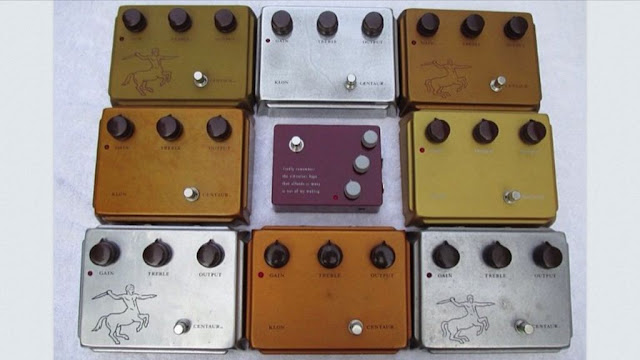







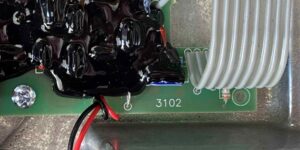














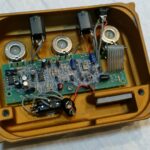
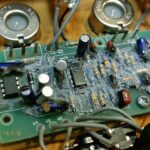

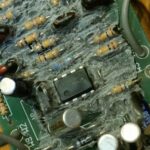
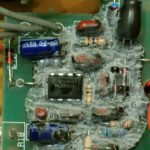
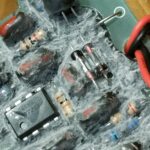
The history and info was very helpful and enlightening! Many thanks for putting it all together. I’m sure an actual Klon sounds great and all, but my Decibelics Golden Horse is and will be the ONLY drive pedal on my board.
Great piece. However, instead of buying a Centaur I bought 2 Gretsch Electromatics, a Kieran Downes custom, an Epiphone Les Paul Custom Pro, a MIM Fender Telecaster, a Fender Deluxe amp, an Orange Rockerverb, 10 pedals (including 3 by Decibelics), and had enough left over for a fine dinner for me and the wife at Ruth’s Chris Steakhouse. I would put my Decibelics Golden Horse up against a Centaur any time, anywhere.
Amazing guide!
I would be happy with a decibelics big vintage klone!
Amazing guide, thank you!
About to pull the trigger on a Klon Centaur and trying to get some confirmation of the authenticity.
The seller has email comms with the shop where the pedal was purchased in 2007 (out of business now) and will try to retrieve the money transfer via his bank.
Glad you liked the guide!
It looks quite good at first glance, but the image is too blurry to make a definitive assessment. I suggest asking the seller for clearer, high-quality, detailed photos, and request they include a piece of paper with your name on it in each picture. Then, examine them thoroughly. Best of luck!
My klon has no Serial number ! Just a name on it….? What’s that reason thx
Interesting! Would you mind sending a photo?
I bought it almost 20 years ago…
See the photo
Fascinating indeed! That’s definitely Bill’s handwriting, so I assume it was a special request from this guy named Enoch. Thanks so much for sharing – you’ve got a unique piece there!
Many thx
Amazing guide, thanks for sharing your knowledge!
I purchased two gold Klon from Bill via exactly the method you described here – over the phone. Serials 2121 and 2122 (I bought one for my tech, he turned me on to the Klon through one he had on loan in the shop for a bit) with receipt dated 2024.04.24. They were $279 each.
Great story! Do you guys still have them? You meant year 2004, right?
Sorry, typo on my part. April 24, 2000. Not sure if I still have the receipt but I have a photo of it for sure, if you’d like a copy.
With the serials and date, I have enough information to add to my database. Thank you so much!
I still have mine, I think my tech sold his a few years ago!
Excellent guide and woderfull pedals, Guillem!
Keep up the great work!
Thank you, really appreciate it!
What were the measurements of the Klon cardboard box?
8.6″ x 5.31″ X 3,34″
22 x 13.5 x 8.5 cm
Fantastic research!
Thank you!
Thank you for the education
Thanks so much for reading it — really glad you found it helpful!
What a great guide, I am very fond of it! Hats-off, Guillem!
Thanks Ben! Happy to hear you found it interesting and appreciate your comment!